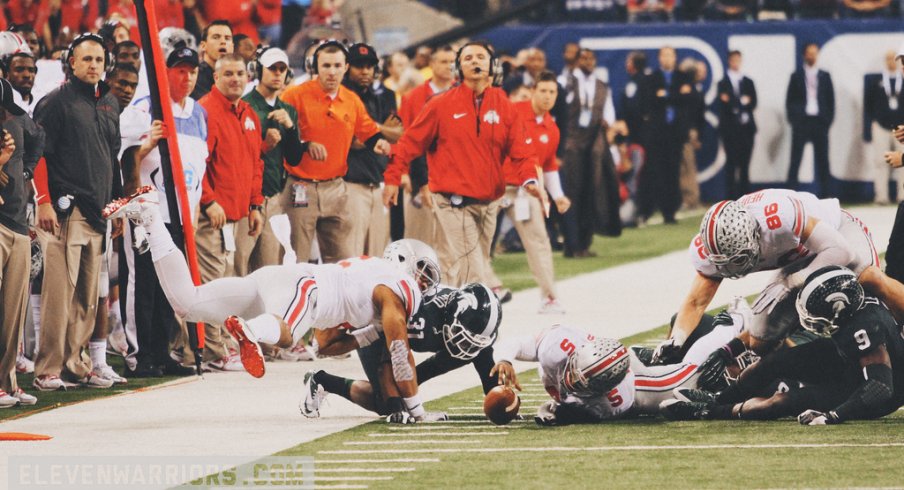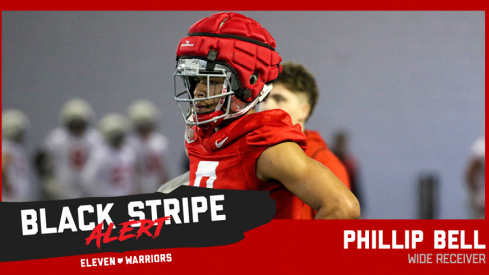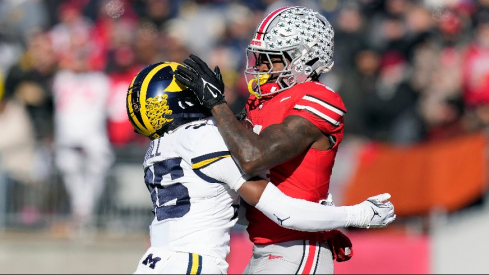When coaches find themselves in tense situations late in a game, they often themselves one of the following questions:
- Who is your best player?
- What is your best play?
In many cases, the answer to #1 almost always involves the answer of #2. When the New England Patriots famously went for it (and failed) on a 4th down against their rivals in Indianapolis, the hot takes that followed tended to focus more on the decision to go for it more than the fact that Tom Brady's pass to Wes Welker fell incomplete. Brady was their best player, Welker his best receiver.
But what about when the best player on your team isn't involved in your best play?
On the same filed in which Brady, Welker, and the Patriots fell short, Urban Meyer faced this dilemma during the waning moments of the 2013 Big Ten Championship game. Riding a 24 game winning streak and looking a spot in the BCS National Championship straight in the eye, the Buckeyes faced a critical fourth down as they trailed by three points late in the fourth quarter.
What happened next has caused Ohio State fans to keep looking back, often criticizing the decision to give the ball to Braxton Miller instead of Carlos Hyde in that critical situation. Much of the criticism stemmed from the viewpoint that the Buckeyes' best play, the Inside Zone, featured Hyde. After so many successful Inside Zone runs over the previous two seasons, many Ohio State fans began to believe that Hyde had taken the mantle as the team's best (or at least, most effective) player.
So if that was truly the case, then why wasn't Inside Zone called on that critical fourth down? Because it would've been the wrong call.
Trouble Inside
Knowing the Buckeyes would lean heavily on this play, the Michigan State defensive coaching staff prepared a game plan designed to consistently bring more defenders than the Ohio State offense could block.
Before the ball is snapped on every play, the defense has an automatic numbers advantage, given that the offense can only have 10 blockers for the man with the ball, while the defense has 11 men trying to tackle him. However, modern offenses have countered by forcing defenses to play at least one or two safeties deep enough to help cover receivers downfield.
The Spartans weren't going to play that game, however. Although they lined up in what appeared to be a Cover 4 defensive look, they effectively played the Buckeye wide receivers in man-to-man coverage all night, leaving all-conference safety Isaiah Lewis to constantly help stop the inside run. On this, the first time Inside Zone was called that night, the Spartans had seven defenders to defend the 5 Buckeye lineman as well Hyde and Miller, the two potential ball carriers.

At the first sign of a run, Lewis immediately crashed down towards the line to help, as he would often that evening on his way to recording a game high 13 tackles.
This wasn't the first time Meyer and the Buckeyes had seen this from an opponent, however. Using the constraint theory of offense, Meyer and offensive coordinator Tom Herman began looking for ways to exploit the ways in which the defense has begun cheating, in an effort to get a more balanced look the next time they ran Inside Zone.
As Ross has done a great job of breaking down in the past, Meyer and Herman like to package the inside zone with a quick passing play, which initially drew strong results against the Spartans.
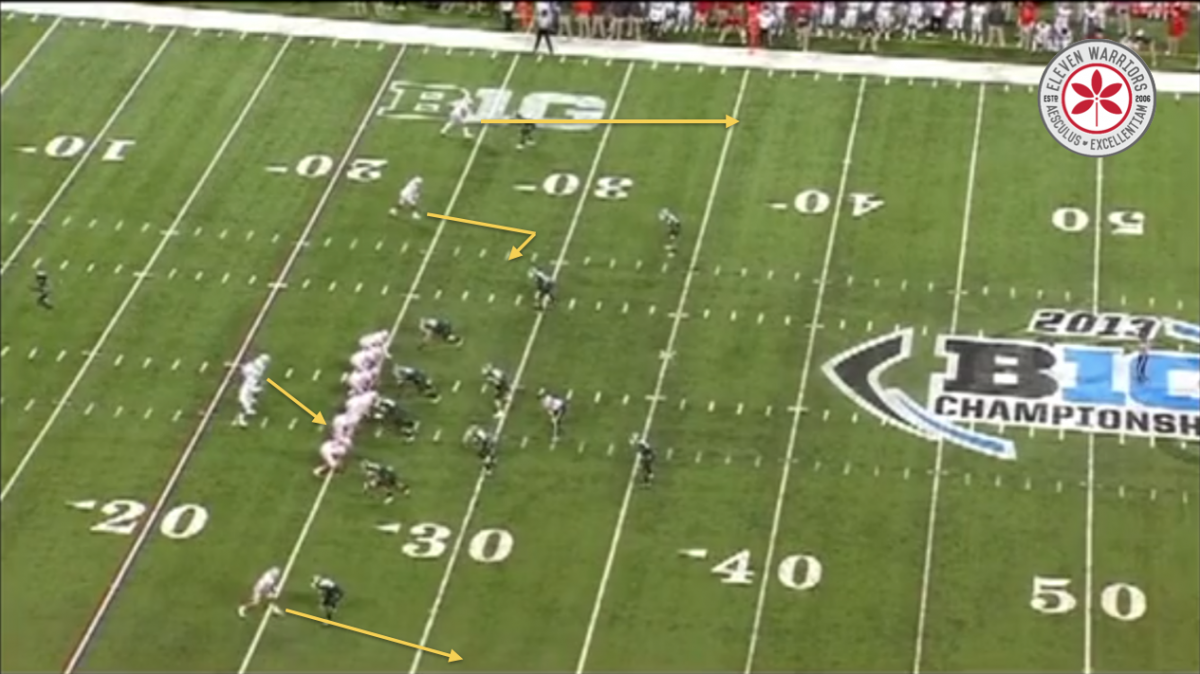
Immediately after taking the snap, Miller looks to see if the MSU defender respects the short route from slot receiver Philly Brown.
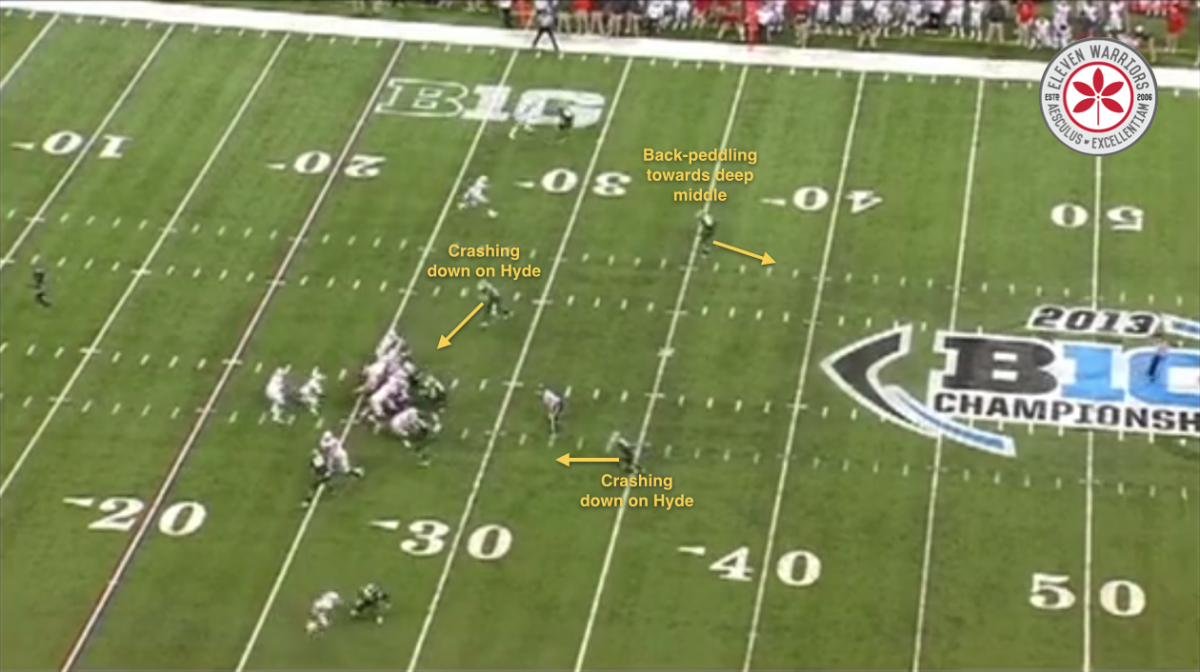
Since the slot defender immediately crashes down on the potential run, Miller keeps the ball and looks to throw. The result is a wide open Brown, and a 10 yard gain.
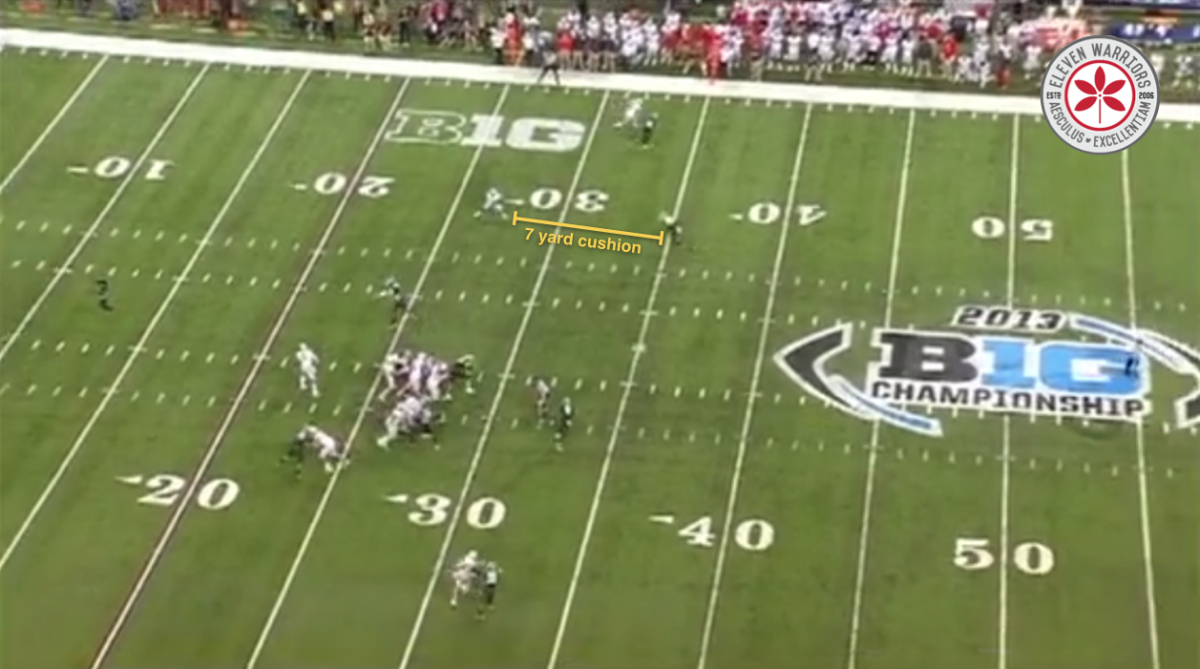
Another way the Buckeyes attempted to gain an advantage with the Inside Zone was by adding a "wham" block from the tight end. The wham acts like a pulling linemen, kicking out an otherwise unblocked defensive end.
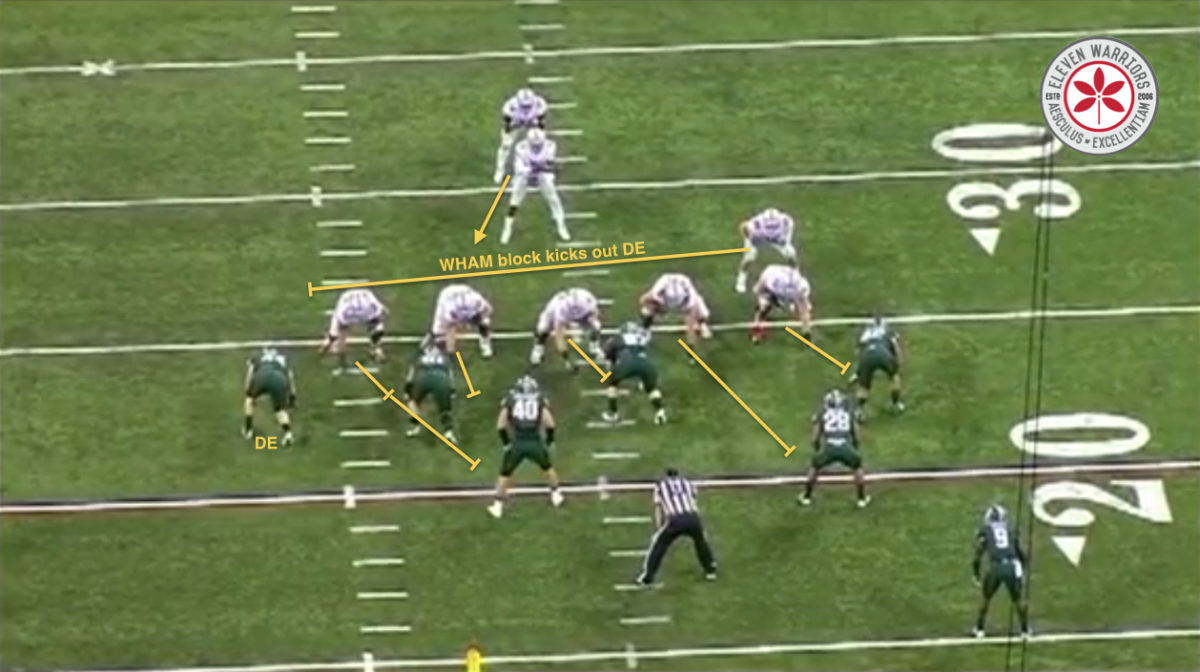
Although Heuerman successfully executed the wham block, the Spartans still had a numbers advantage, as outside linebacker Taiwan Jones (#34) immediately ran into the box at the first sign of a run.
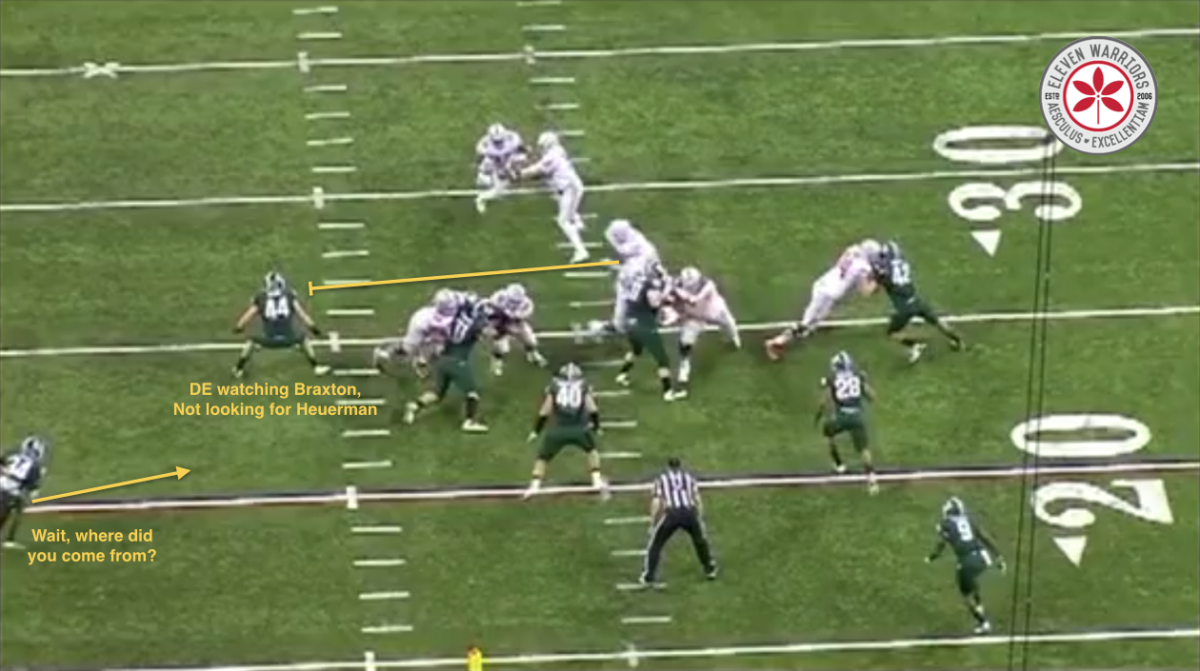
Additionally, the Spartans began slanting their defensive linemen away from the strength of the formation, often causing a double team from Buckeye blockers, and keeping the linebackers behind them unblocked, as was the case here with #40, Max Bullough.
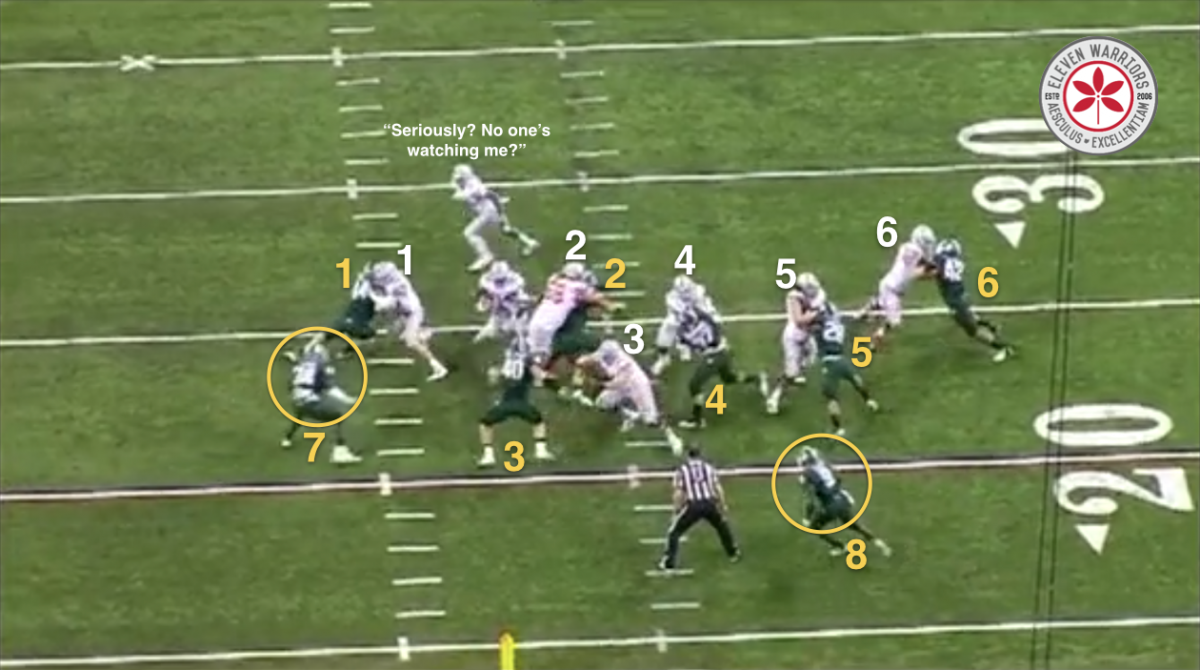
By this point, the Spartans had made it clear that they would do whatever necessary to take away Hyde and the Inside Zone. The Spartans had a numerical advantage of usually more than one defender every single time the Buckeyes attempted to run it. In fact, an 18 yard scamper in which Isaiah Lewis was tripped by the Umpire on his way to making a tackle was easily Hyde's longest run of the night.
The Spartans had put the burden on the Ohio State receiving corps, forcing them to win their one-on-one battles. However, only Philly Brown's 5 catches (many of which came on the packaged plays described above) were the only consistent threat. Devin Smith, Jeff Heuerman, and Carlos Hyde each had one catch, giving the Buckeyes a season low 101 yards through the air.
Take It Outside
The Buckeyes had to find a way to gain back the numerical advantage. By making Miller the designed ball-carrier, the Buckeyes immediately tilted the scales back in the right direction. The counter trey had been a staple of the OSU running game all year, and remained effective on this evening.
Yet the most effective play of the night was a much less used concept seen from the Buckeyes, the outside lead zone.
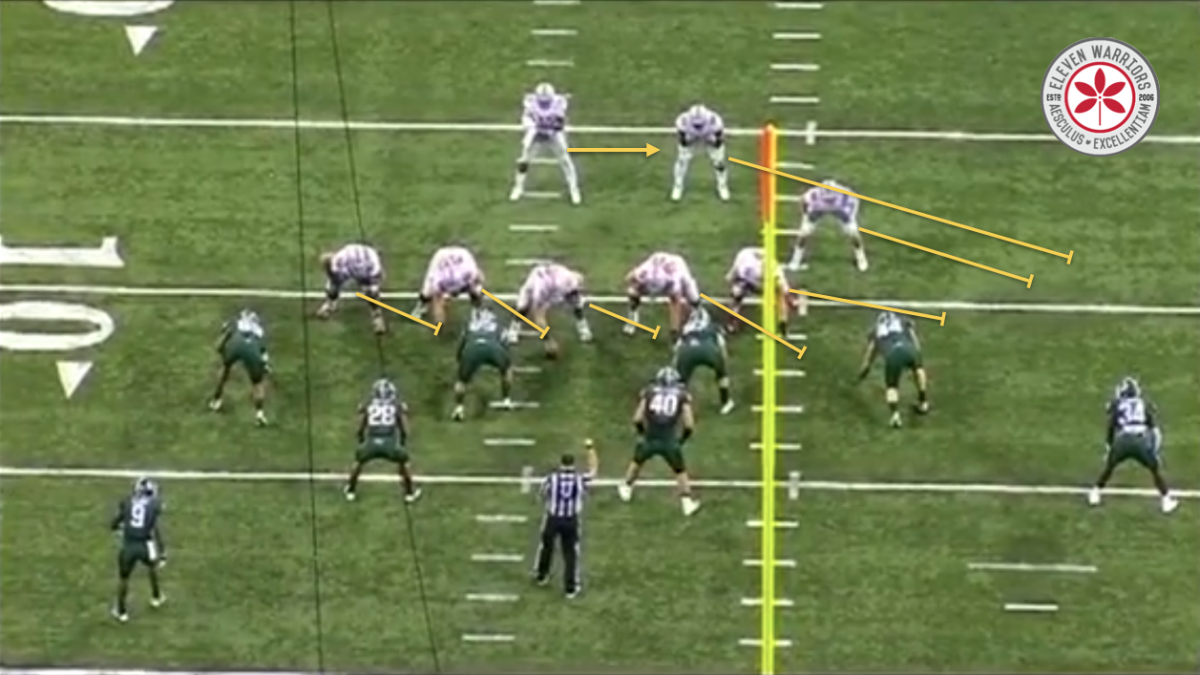
By stretching the defense laterally and turning Carlos Hyde into a lead blocker, the Buckeyes could gain an advantage to one side of the field.
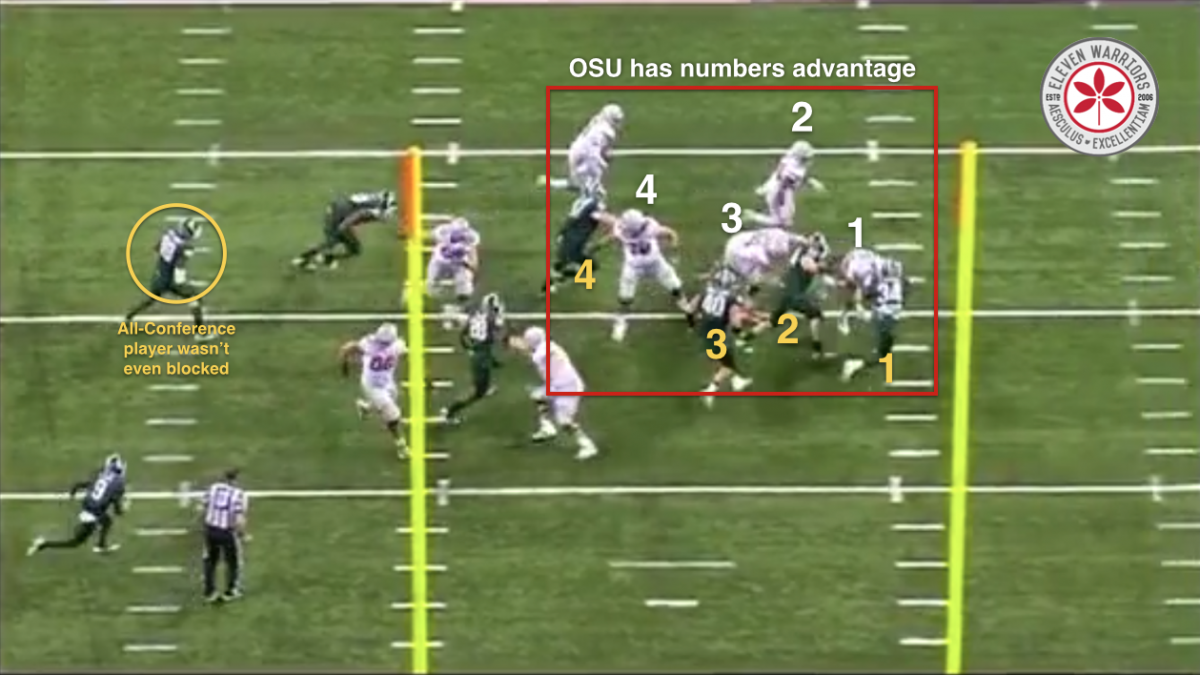
With Miller's exceptional speed, the play becomes a foot race between he and the defensive lineman, a battle he'll win every time. Outside Zone proved effective throughout the entire night, resulting in both of Miller's rushing touchdowns and many of his game high 142 rushing yards.
4th and Short
All this background sets us up for that critical series in the fourth quarter. The Buckeyes find themselves down 27-24 and have the momentum coming off a partially blocked punt by Ryan Shazier, and have taken over inside Michigan State territory.
On second down, the Buckeyes ran the Inside Zone with Hyde so many fans had been waiting for. But before the ball was even snapped, the Buckeyes were at a disadvantage.
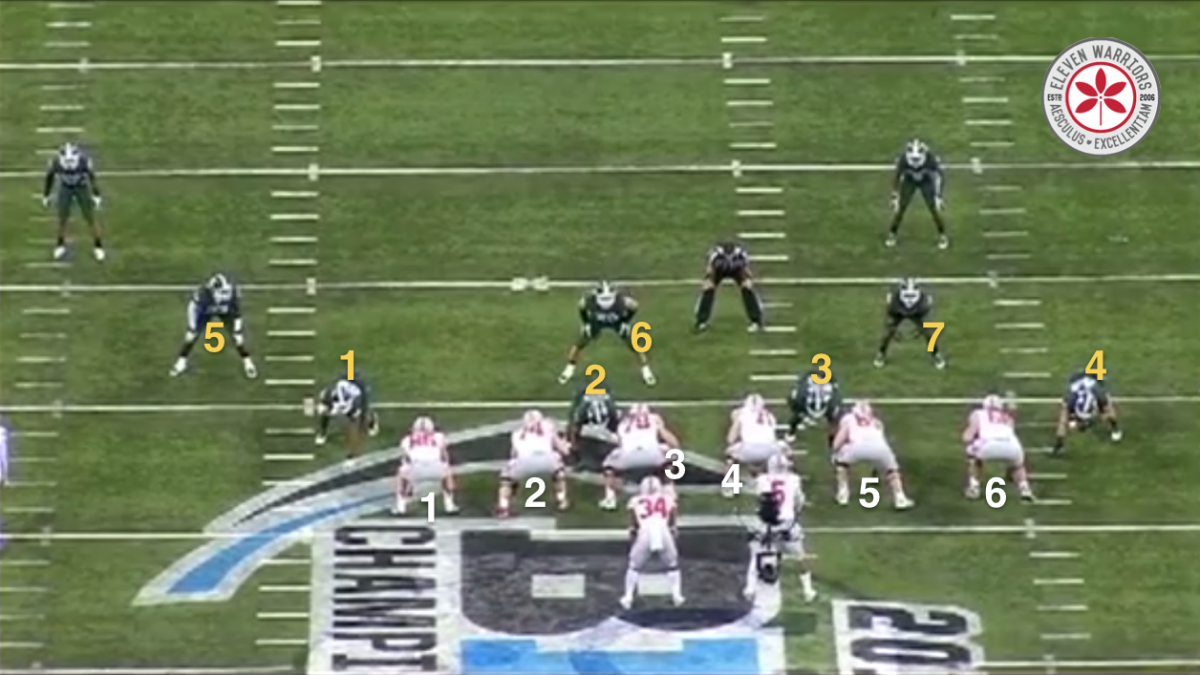
The Spartans had seven defenders near the line of scrimmage waiting for Hyde, with both safeties nearby, a familiar story at this point.
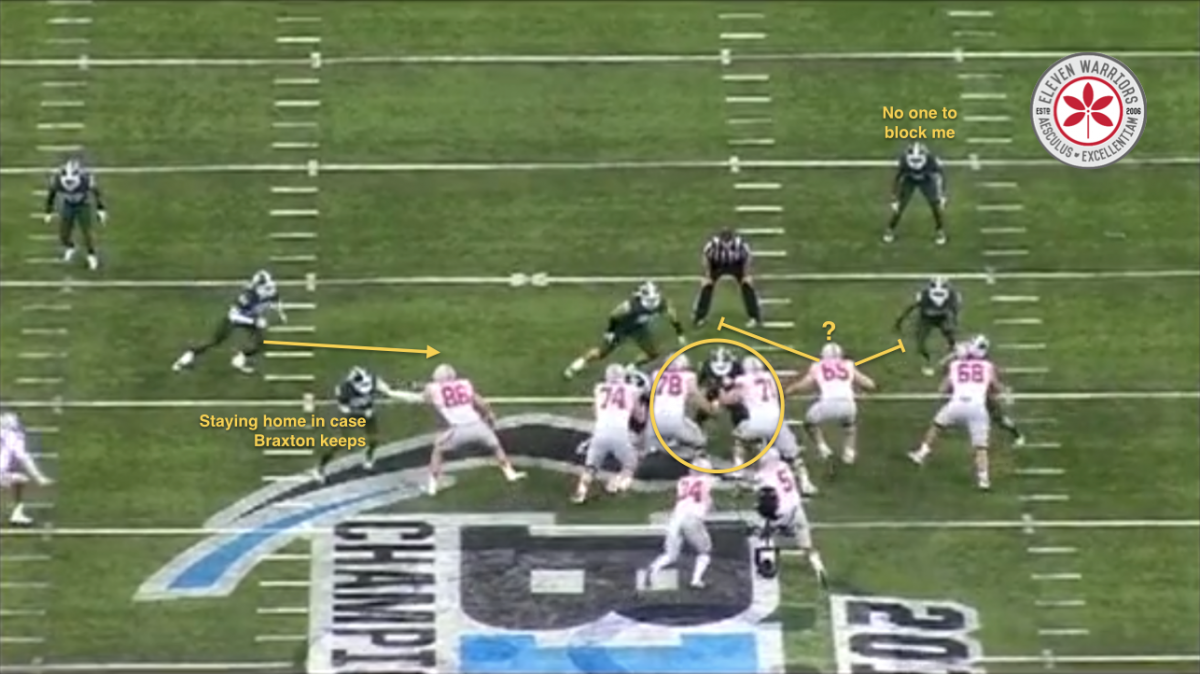
Once again, the Spartans slanted their linemen, causing OSU Center #71, Cory Linsley, to have to help on the nose tackle instead of blocking a linebacker. The result was right guard #65 Pat Elflein having to choose which defender to take on.
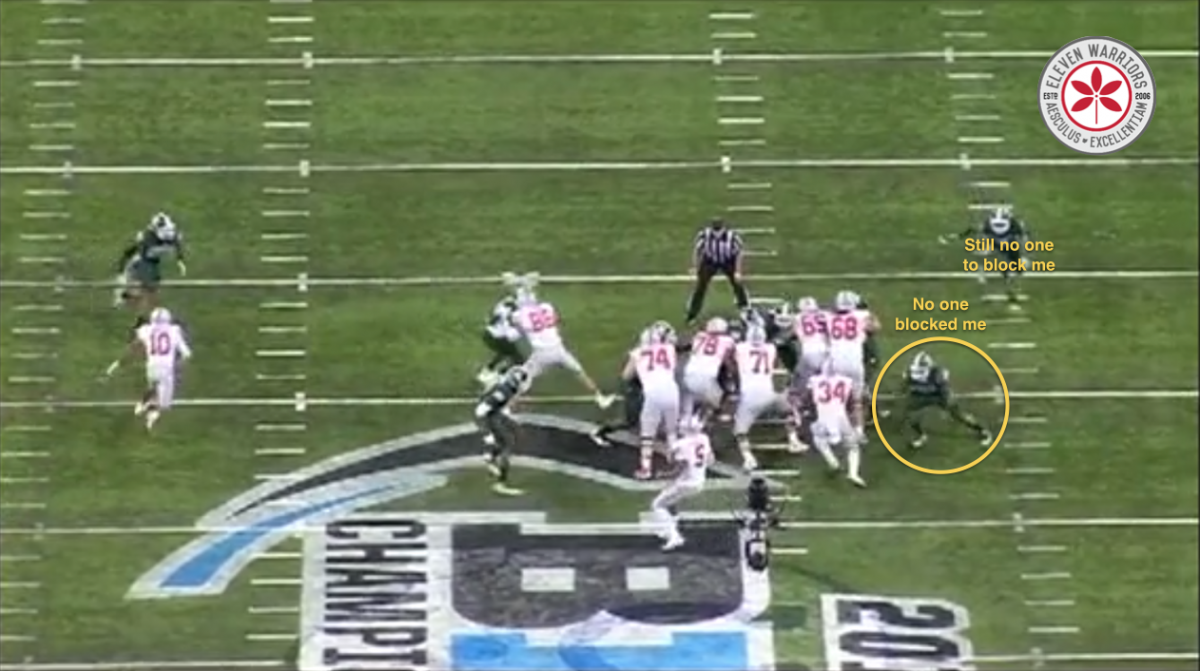
Elflein chose to block Bullough, leaving linebacker Denicos Allen untouched to make the tackle. This was not Elflein's fault, as he can't be counted on to make both blocks, nor is it Linsley's, who was following his rules on the play. The Buckeyes were simply in a no-win execution if both teams executed properly, which is exactly what happened.
The Buckeyes now found themselves on third down, and with the passing game proving ineffective, the Buckeyes went to the plays that actually had been working.
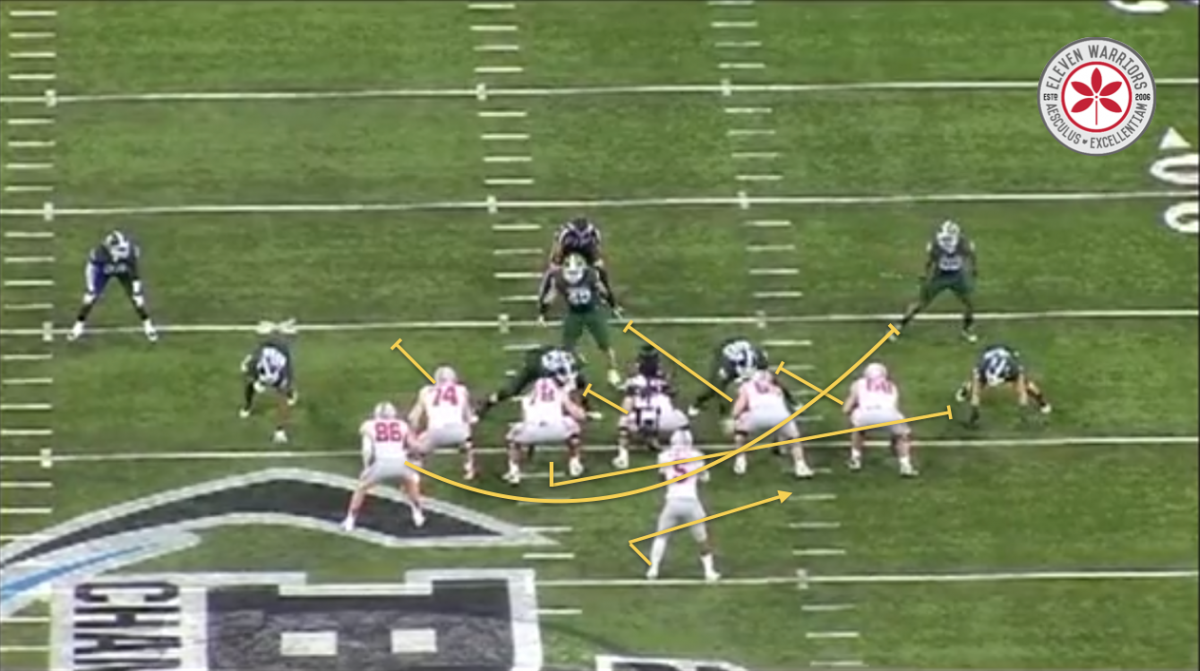
While the Spartans had seven defenders near the line, the Buckeyes would look to gain an advantage to one side by pulling left guard #78 Andrew Norwell and tight end Jeff Heuerman back to the right.
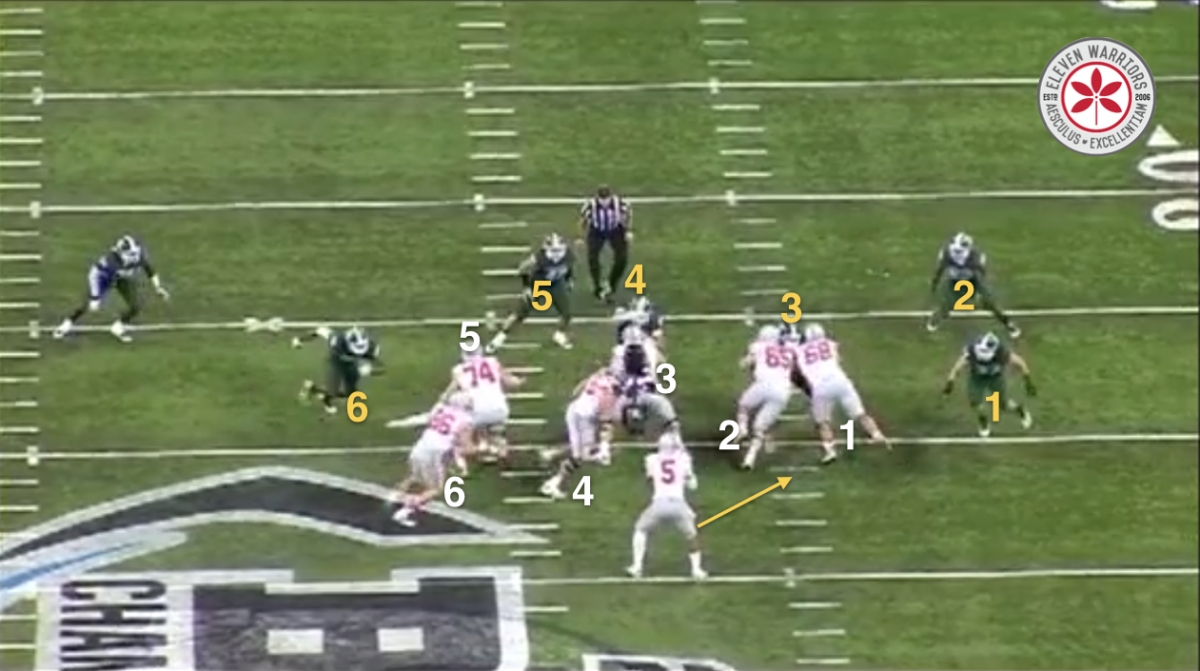
The Spartans' numerical advantage was gone, as the Buckeyes had enough blockers to take on all the defenders. All Miller needed was for each of his teammates to block their man, and there wouldn't be a soul to touch him.
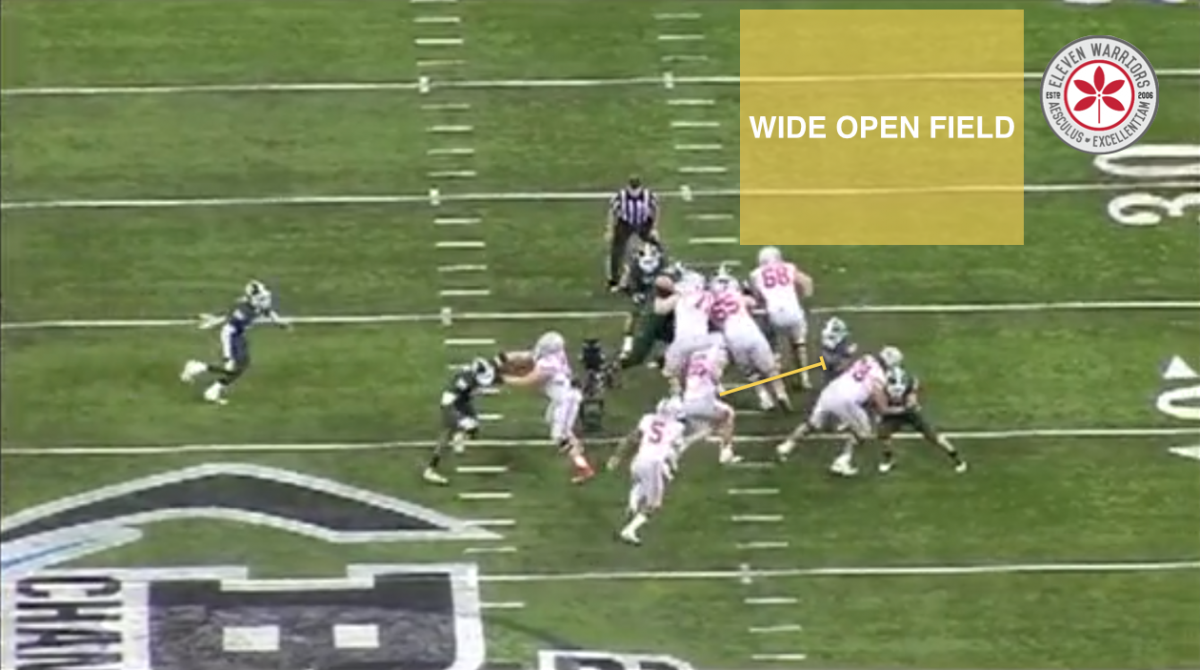
Unfortunately, Heuerman couldn't complete his block on the play, and the Buckeyes now faced fourth down. At this point, the Buckeyes pulled out their last, and most effective play in the bag, the outside lead zone.
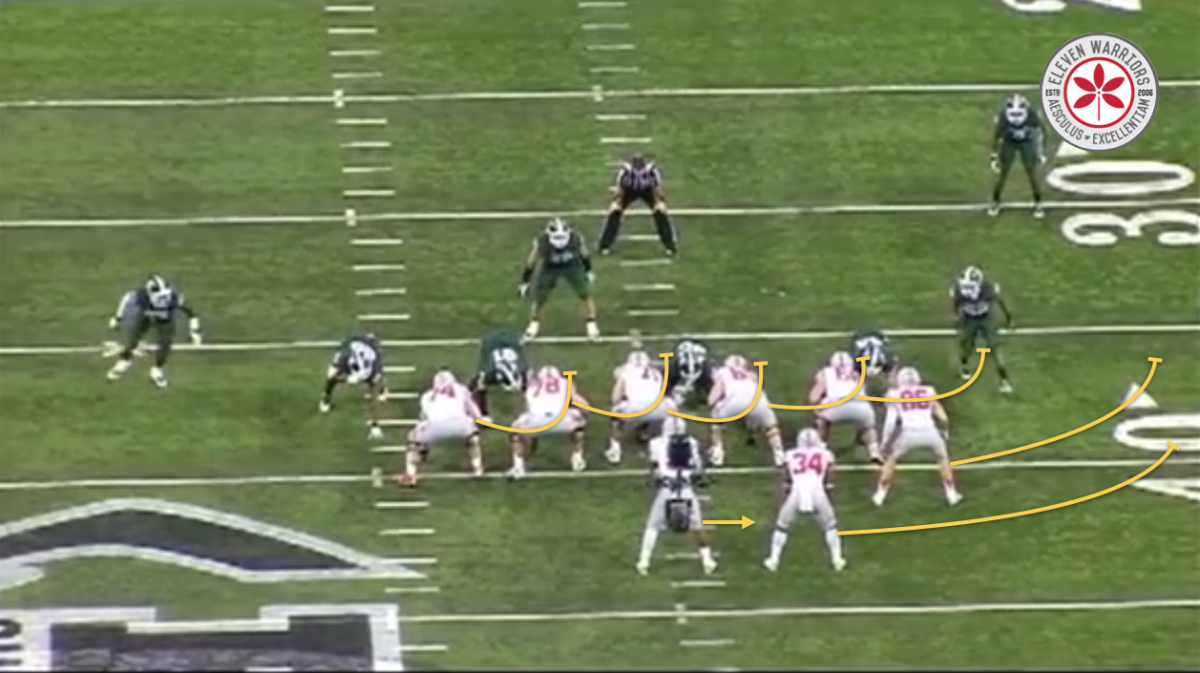
Given that the OSU blockers would move laterally, making the backside defenders useless, the Buckeyes would've had a big numbers advantage for Miller, especially given that he only needed a couple yards.
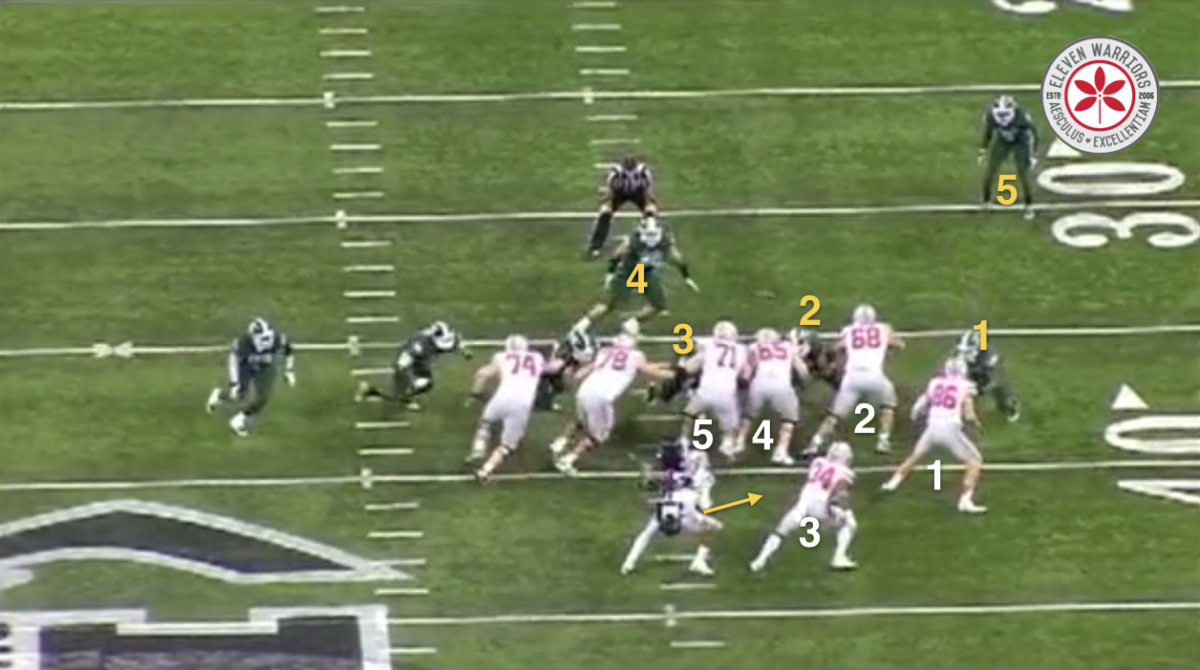
At this point, we all know the outcome.
Coaches spend hours and hours looking to gain an advantage over their opponents. The Spartans found one by playing man-to-man outside and leaving their safeties and all three linebackers to help stop the run. But the Buckeyes found an advantage as the game went on, with designed runs for Miller.
There is no question that the Buckeyes had a better chance of converting with the outside zone to miller, than by running Hyde inside. Meyer had to give his players a chance to succeed, which they had on both third and fourth down. Unfortunately, the Buckeyes didn't execute perfectly, and critical blocks were missed.
It's easy to blame coaches in these situations. They're the ones in charge, and get paid handsomely to do so. But they aren't the ones on the field. All they can do is put their players in the best position to succeed, which I believe they did on that night in Indianapolis.
